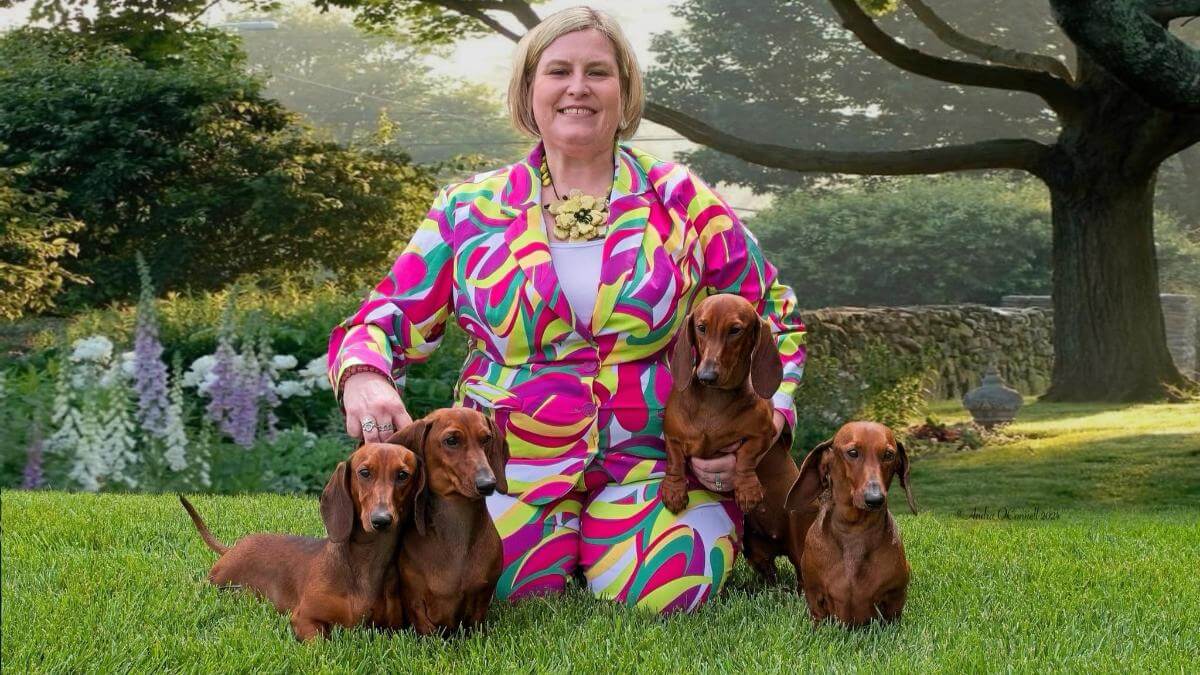
Home » Lexa Richmond | Hialeah Dachshunds

Lexa Richmond
1. I was raised in Midland, Texas, and now reside in the Dallas-Fort Worth area in Bedford. I got my first show Dachshund in 2002 and bred my first litter of Hialeah Dachshunds in 2004. I have bred 49 champions to date, am a Breeder of Merit, and have been a judge of Dachshunds since 2017. I bred the top-producing Smooth bitch for 2016, named Hialeah’s Effie Trinket ROMX, who has produced nine champions. Her son, “Finnick,” GCHB Hialeah’s I Volunteer As Tribute, won the Variety at the Dachshund Club of America National Specialty Show in 2021.
2. The Dachshund can be summed up in three words: long, low, level. Although this language is not specifically used in our Breed Standard, to someone not familiar with the breed this is a good starting point. Dachshunds are not thought of as a movement breed, but they really are. They should have free movement and be able to clear ground to do the job for which they are bred. The Dachshund front is the hallmark of our breed. The “wraparound front” is probably the most difficult thing to learn for new judges and exhibitors not familiar with our breed. The wraparound front includes the long and well-laid-back shoulder blades and an upper arm that is ideally the same length as the shoulder blade. The forearm is short and slightly curved inwards. The combination of the shoulder blade, upper arm, and curved forearm create “parentheses” that enclose the rib cage, creating the correct wraparound front, like an egg sitting on a stand. The other hallmark besides the wraparound front and movement is temperament. The Dachshund should be clever, lively, and courageous to the point of rashness, and not display any shyness.
3. The Dachshund is still a popular Top 10 Breed, so there are usually enough homes to support breeding litters each year. The Dachshund is versatile, coming in three different coats and two different sizes; they can participate in a multitude of activities, so there is always something for anyone who wants a Dachshund.
4. I believe that new technologies like DNA profiling, genetic testing, and advanced breeding techniques have changed the way I run my breeding program. Every male that I have bred will have a DNA profile completed. I also have been more aware of COIs (coefficient of inbreeding) in my program and am currently doing more study and research in that area.
I also believe that social media has benefited the fancy greatly. It is so much easier now to collaborate for improvement, advancement, and preservation of our genetic populations. Communication about our breed is a way to advance our breed globally. More importantly, this is also a way to unite and work with master preservation breeders in other breeds. I truly believe that collaborating with other master breeders in different breeds will elevate any breeding program.
5. I think the “adopt, don’t shop” philosophy is still a strong war cry in society. I feel the cultural shift towards mixed-breed dogs and adoption is driven by a broader societal change, where people are increasingly prioritizing health, ethical practices, and the well-being of animals. There is an over-saturation in the public through the social media machine of the public jumping on the band wagon against “breeders.” I try to encourage research to learn about the importance of reputable breeders and purebred dogs, while educating on the health and wellness of animals in these programs.
6. In Dachshunds, we are having more new exhibitors coming in, which is great for the sport itself, but unfortunately, some of the newer exhibitors seem disinterested in improving their breeding program and only seem to want to win. They are justified in doing so because we have so many new judges without a solid understanding of the difference between sound dogs and an undesirable dog, so they win. There are some newer judges that I have seen do a great job and some that need more education in our breed.
We are still fighting the battle of getting more young people into the sport. With the demands of the world today, most young people with families are busier than ever with just “life.”
I’ve also noticed a trend to put judges “on blast” through social media in groups or forums. One bad experience or a loss under a judge doesn’t make them a criminal, and we need to start normalizing the American Kennel Club (AKC) Code of Sportsmanship as a mantra and not just as a guide.
7. The available resources we now have from AKC and our parent clubs as breeders and exhibitors have rapidly grown. The increased participation of Owner-Handlers, easier access to show results online, and a greater variety of activities offered on the weekend means higher participation from those who want to do other things with their dogs besides Conformation. As an educator, I think that the requirement of completing the Stewards of Children training is a vital component for judges, handlers, and stewards to safeguard our younger exhibitors.